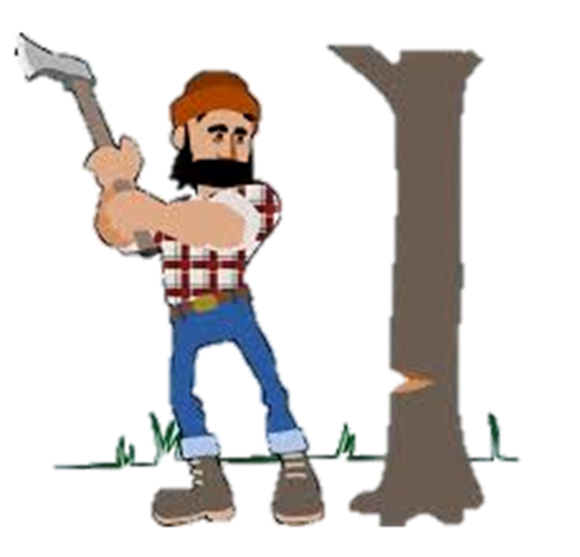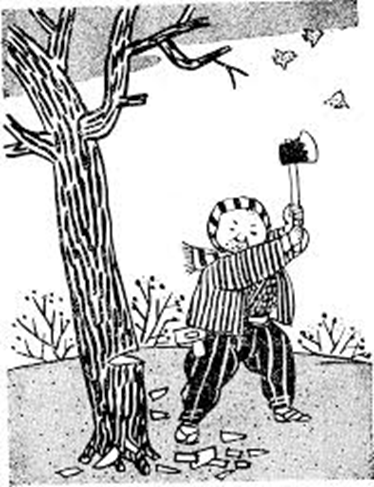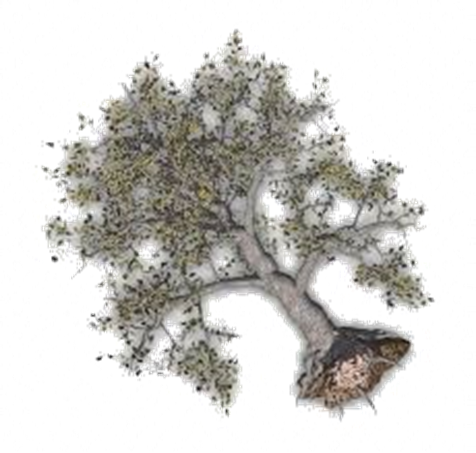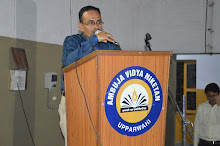Posted by : Empowerment Rules the World
Tuesday, 18 December 2018
On Killing A Tree
By Gieve Patel

Introduction to the lesson
The poet sensitizes the reader and highlights the fact that trees are living things. He equates trees with humans to convey that trees should not be cut because destroying trees is just like killing a human being. A tree does not die by merely cutting because it regrows from where it is cut. If it has to be destroyed, then it has to be uprooted.

Poem and Explanation
It takes much time to kill a tree,
Not a simple jab of the knife
Will do it. It has grown
Slowly consuming the earth,
Rising out of it, feeding
Upon its crust, absorbing
Years of sunlight, air, water,
And out of its leprous hide
Sprouting leaves.
Not a simple jab of the knife
Will do it. It has grown
Slowly consuming the earth,
Rising out of it, feeding
Upon its crust, absorbing
Years of sunlight, air, water,
And out of its leprous hide
Sprouting leaves.
Jab: sudden rough blow
Leprous hide: discoloured bark
Leprous hide: discoloured bark
A simple cut does not destroy a tree. A tree grows gradually, it is rooted in the soil. A plant takes nutrition from the soil to grow into a big tree. The tree is firmly bound with the soil. It takes in sunlight, water and air to grow into a strong trunk and have numerous leaves.
So hack and chop
But this alone won't do it.
Not so much pain will do it.
The bleeding bark will heal
And from close to the ground
Will rise curled green twigs,
Miniature boughs
Which if unchecked will expand again
To former size.
But this alone won't do it.
Not so much pain will do it.
The bleeding bark will heal
And from close to the ground
Will rise curled green twigs,
Miniature boughs
Which if unchecked will expand again
To former size.
Hack: cut roughly by striking heavy blows
Humans cut and chop the bark of trees into many pieces but that is not sufficient to destroy the tree. The point of the tree which gets cut gives out sap just like a human being bleeds. Gradually, this would heals and from there new branches start growing again.

No,
The root is to be pulled out —
Out of the anchoring earth;
It is to be roped, tied,
And pulled out — snapped out
Or pulled out entirely,
Out from the earth-cave,
And the strength of the tree exposed
The source, white and wet,
The most sensitive, hidden
For years inside the earth.
The root is to be pulled out —
Out of the anchoring earth;
It is to be roped, tied,
And pulled out — snapped out
Or pulled out entirely,
Out from the earth-cave,
And the strength of the tree exposed
The source, white and wet,
The most sensitive, hidden
For years inside the earth.
Anchoring earth: trees are held securely with the help of the roots in the earth
Snapped out: chopped out
Snapped out: chopped out
The poet says that in order to kill the tree, it has to be uprooted. One has to separate the tree from the Earth which supports it. The roots of the tree bind the tree with the soil in the pit of the Earth. From there, the most sensitive and hidden part of the tree - the roots have to be detached. The roots are white in colour and are damp.
Then the matter
Of scorching and choking
In sun and air,
Browning, hardening,
Twisting, withering,
And then it is done.
Of scorching and choking
In sun and air,
Browning, hardening,
Twisting, withering,
And then it is done.
Scorching and choking: the drying up of the tree after being uprooted
Once the tree has been uprooted, then gradually it withers and dries up with the action of heat and wind. The trunk will become brown, twist and will harden. Finally, the tree will die this way.
Literary Devices
1. No rhyme scheme is there in the poem. It is written in free verse. There is no rhyme or rhythm.
2. Enjambment: When one sentence continues into two or more lines.
Not a simple jab of the knife
Will do it. It has grown
Slowly consuming the earth
2. Enjambment: When one sentence continues into two or more lines.
Not a simple jab of the knife
Will do it. It has grown
Slowly consuming the earth
Rising out of it, feeding
Upon its crust, absorbing
Years of sunlight, air, water,
And out of its leprous hide
Sprouting leaves.
Upon its crust, absorbing
Years of sunlight, air, water,
And out of its leprous hide
Sprouting leaves.
The most sensitive, hidden
For years inside the earth.
For years inside the earth.
3. Metaphor: indirect comparison
Leprous hide - the uneven colour of the surface of the trunk of a tree is compared to the skin of a person suffering from leprosy.
Leprous hide - the uneven colour of the surface of the trunk of a tree is compared to the skin of a person suffering from leprosy.
Bleeding bark - the sap coming out of tree where it is cut is compared to the bleeding from the wound in a human’s body.
4. Alliteration: repetition of a consonant sound in 2 or more closely places words.
Bleeding bark - ‘b’ sound
White and wet - ‘w’ sound
Bleeding bark - ‘b’ sound
White and wet - ‘w’ sound
5. Repetition: a word or sentence is repeated to lay emphasis on it.
‘Pulled out’ is repeated
‘Pulled out’ is repeated
Summary
“On Killing a Tree” is a sensitive poem. The poet persuades the reader not to destroy trees and equates it with “killing” a human being. He says that a plant takes sunlight, water, air and nutrients from the soil to gradually become a huge tree. It develops a strong trunk and gets numerous leaves.
Merely cutting the trunk of the tree does not kill it. When a tree is cut, the sap flows out just like a wounded man bleeds. Once the wound heals, new branches and tiny leaves grow from there which grow into trees.
In order to destroy a tree, it has to be uprooted. The roots which are white in colour and are damp due to the moisture that they get from the soil are hidden in a pit in the Earth. These roots are the most sensitive part of the tree as they bind it to the earth. In order to kill the tree, these roots have to be detached from the soil.
Once the roots are detached, the tree starts dying, It withers, dries up with the action of heat and wind, twists, hardens and finally, dies.
Merely cutting the trunk of the tree does not kill it. When a tree is cut, the sap flows out just like a wounded man bleeds. Once the wound heals, new branches and tiny leaves grow from there which grow into trees.
In order to destroy a tree, it has to be uprooted. The roots which are white in colour and are damp due to the moisture that they get from the soil are hidden in a pit in the Earth. These roots are the most sensitive part of the tree as they bind it to the earth. In order to kill the tree, these roots have to be detached from the soil.
Once the roots are detached, the tree starts dying, It withers, dries up with the action of heat and wind, twists, hardens and finally, dies.
Question and Answers
1. Can a “simple jab of the knife” kill a tree? Why not?
A. No, a simple jab of the knife cannot kill a tree. The place from where the tree is cut will give out sap and once the wound heals, new branches and leaves will grow from it which will develop into trees.
2. How has the tree grown to its full size? List the words suggestive of its life and activity.
A. The tree has grown by consuming nutrients from the Earth, absorbing sunlight, air and water. The words suggestive of its life and activity are - consuming the earth, Rising out of it, feeding Upon its crust, absorbing years of sunlight, air, water.
3. What is the meaning of “bleeding bark”? What makes it bleed?
A. Bleeding bark refers to the sap which flows out of the tree’s bark where it is cut. The tree bleeds when it is cut with a knife.
4. The poet says “No” in the beginning of the third stanza. What does he mean by this?
A. ’No’ means that the tree will not die by cutting or chopping the trunk.
5. What is the meaning of “anchoring earth” and “earth cave”?
A. “Anchoring Earth” means that the Earth supports the tree firmly. “Earth cave” refers to the pit in the Earth where the roots of the tree bind it firmly to the Earth.
6. What does he mean by “the strength of the tree exposed”?
A. “the strength of the tree exposed” means that upon being uprooted, the most sensitive and important part of the tree i.e. the roots will no longer remain hidden in the Earth.
7. What finally kills the tree?
A. The tree dies when it is uprooted. When it is detached from the Earth, it withers, hardens twists and finally dies.








Very bad
ReplyDelete
ReplyDeletebad👎🏻👎🏻